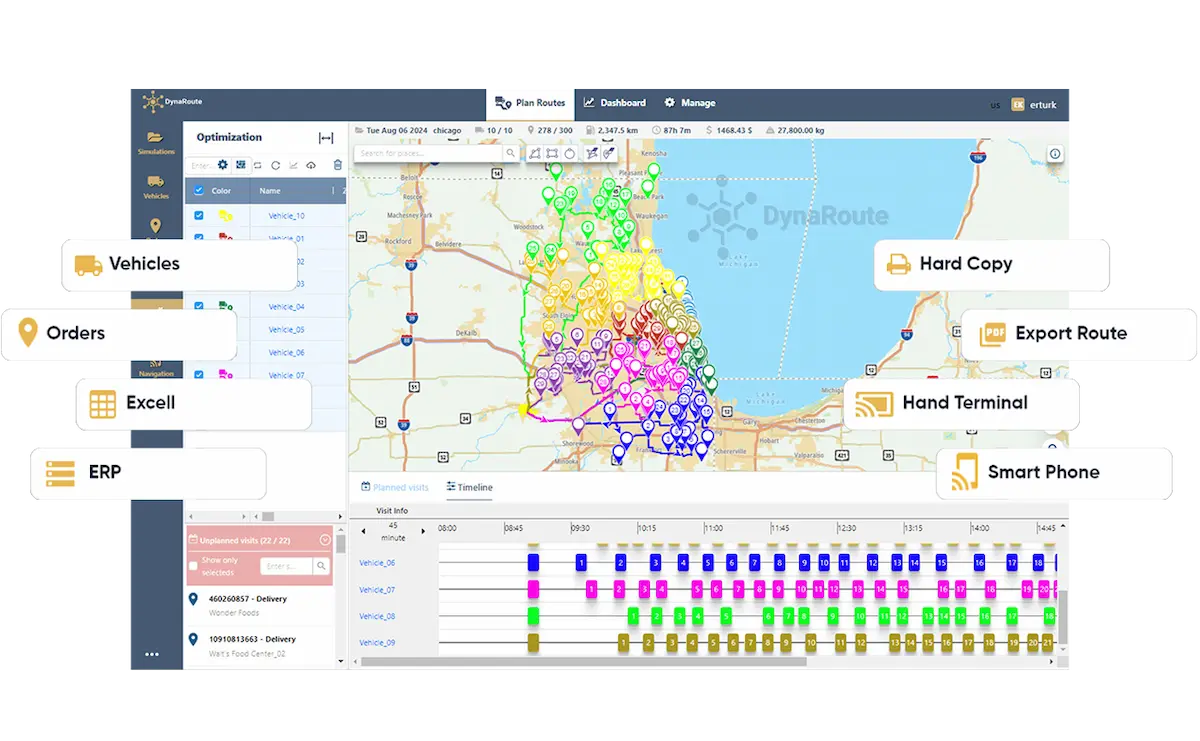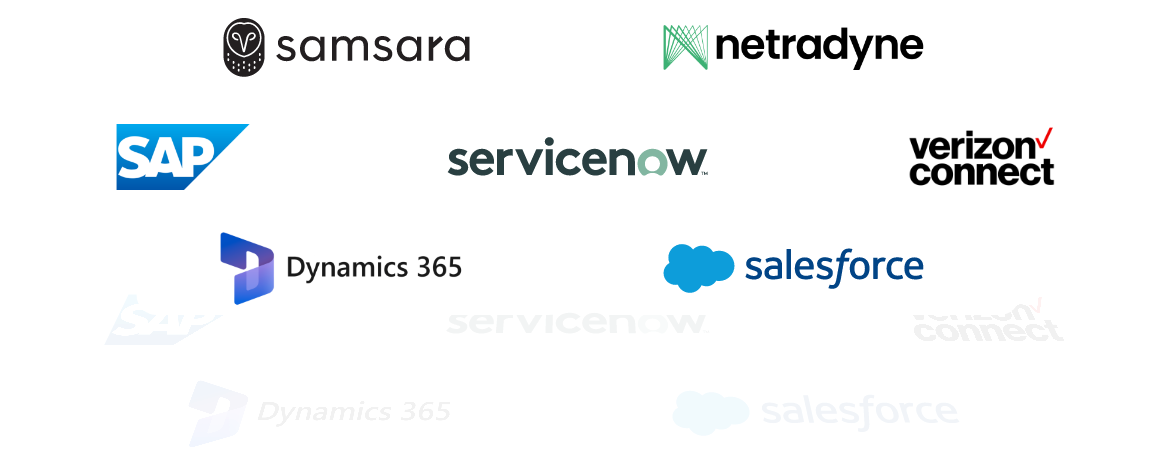
Smarter Routes Better Deliveries
Smarter Routes Better Deliveries
Next generation dynamic fleet route
planning and optimization solutions
with artificial intelligence algorithms
Fast and reliable routes in 5 minutes , superior features
and almost half the price compared to competitors in the market
Free 15-days account. No credit card required.
(With a working limit of 10 vehicles and 500 stops)



1
Import Orders
Customers orders data is imported into the system (addresses, visit time windows, visit times, coordinates, order quantities etc)
2
PLAN ROUTES
Business rules are defined, customer visit routes are planned and visit sequences are shown on timeline and map
3
SHARE ROUTES WITH DRIVERS
Planned routes are sent to the driver’s mobile app then customer visits are monitored moment by moment
Our AI optimization algorithms automatically provide you with the most time-efficient and cost-effective routes, taking into account vehicle capacities, delivery window skills, visit priority, as well as size, weight and dangerous vehicle restrictions. We’ve managed to help companies make their operations greener and avoid emitting tons of CO2 which is equivalent of planting over million trees. Upgrade to DynaRoute for faster optimization and advanced business critical features.


| MAIN TOPICS | DETAILS |
|---|
• Enter vehicle and driver information via Excel or manually (e.g., vehicle name, license plate, features like cold chain, multiple gates, long vehicle, etc.).
• Address and location details: starting and ending addresses, latitude, longitude, zip code, city, country, warehouse address.
• Visit start and end time windows (e.g., 08:00 AM – 05:00 PM, lunch breaks 12:00 PM – 01:00 PM, legal working times per country).
• Vehicle capacity (kg, m³, pallet, box, unit).
• Define vehicle service zones.
• Driver’s name, surname, cell phone, email, and mobile application information.
• Vehicle and driver skills (e.g., cold chain, wheelchair transportation).
• Costs (fixed cost, cost per km, cost per hour, overhead cost, overtime fee).
• Start and end locations (address, warehouse, latitude, longitude).
• Add, edit, copy, delete order data from Excel or a customer database (ERP).
• Manually enter order data: order ID, customer name, time windows, loading/unloading time, visit time,
• visit priority, order type (delivery, pickup, tasks), assigned vehicle/driver, addresses, locations (latitude,
• longitude), zip code, order quantities (kg, m³, pallet, box, quantity).
• Geocode customer addresses and display them on the map.
• Define order skills (e.g., matching “cold chain” with vehicles that have cold chain capabilities).
• Utilize the “priority” feature to prioritize customer visits (high, medium, low).
• Create thematic maps showing customer sales turnover values with different colors and sizes.
• Define orders based on product specifications and quantities, calculate capacity at the time of loading, and
• upload them to the system.
• Load unplanned orders into the system during customer visits and dynamically add them to routes
• Enhance zone planning with intelligent job clustering, considering driving distances, traffic patterns, highways, driver preferences, and overlapping routes.
• Four methods to create zones:
• Manually drawing polygons on the map based on order locations.
• Automatic clustering considering customer order quantities and vehicle capacities.
• Importing vehicle zones from KML files.
• Creating zones from order locations using the “assigned to vehicle” column.
• Previously created zones can be edited, copied, deleted, and exported to
KML format.
• Optimize routes based on vehicle zones or independently.
• Automatic optimization creates the most efficient routes considering vehicle
capacities and order quantities.
• Balance routes to ensure similar service times for all vehicles.
• Handle unplanned orders by dynamically adding them to existing routes.
• Utilize the timeline feature to manage routes, visit sequences, and visit times.
• Drag & drop functionality to manage orders and routes.
• Multi-Day Long Haul:Optimize routes for long-distance, multi-day travel, ensuring timely arrivals and returns.
• Plan routes for up to a month, considering frequency of visits.
• Cross-Docking:Optimize routes involving large vehicles unloading at cross-dock warehouses and smaller vehicles continuing distribution.
• Road Restrictions Tool (Rrt):Set up restrictions such as: turn restrictions, speed limits, road closures, parking restrictions.
• Create, modify, and delete geofences (circle, custom polygon, or isochrone-based).
• Dynaroute Mobile app for Android and iOS allows drivers to view customer visit
queues and navigate using live traffic data.
• Proof of Delivery (POD) feature for delivery confirmation.
• Drivers can update customer locations and reschedule visits with admin approval.
• Live Track feature for real-time updates on arrival times, deviations, and driver
performance.
• Analyze cost-saving opportunities with distance and time data.
• Dashboards with bar charts, pie charts, and line graphs to measure vehicle/driver
performance.
• Compare planned and actual distances traveled.
• Send regular summary performance reports to managers.
• Integrate with ERP, OMS, TMS, and other third-party software using Dynaroute’s Web Service API.
• Compatible platforms include Microsoft Dynamics, SAP, Salesforce, Oracle Fusion, Zoho, Shopify, and more.
Still got questions?
In the last-mile or on-demand service industry, the ‘travel cost’ parameter is a critical optimization objective. By selecting the ‘duration’ objective, the solver can minimize the time taken for deliveries, ensuring swift last-mile services. Moreover, real-time traffic conditions play a vital role in route optimization. The ‘traffic timestamp’ and ‘departure time’ constraints leverage traffic data to guide the solver in calculating the fastest routes, ensuring prompt deliveries even in congested areas.
In the logistics sector, the ‘capacity’ attribute proves invaluable, allowing businesses to define diverse capacities for vehicles based on weight, volume and more. The ‘pickup’ and ‘delivery’ attributes streamline the handling of shipments across the supply chain. The ‘maximum tasks’ constraint ensures the efficient distribution of tasks among vehicles, maximizing fleet utilization. The ‘cost’ preference helps logistics companies cut down on expenses related to fuel, labor, and vehicle maintenance.
In the field service industry, addressing complex multi-resource scheduling and dispatch challenges is essential. The ‘skills’ parameter becomes pivotal as it guarantees tasks are assigned to workers with the right expertise, such as technicians skilled in specific repairs. Additionally, the ‘time window’ constraint helps ensure timely service appointments and the ‘priority’ parameter enables differentiation between urgent repairs and routine maintenance, optimizing resource allocation.
To enable safety and efficiency in employee transportation, the importance of optimizing pick-up and drop-off sequences cannot be overstated. Leveraging the ‘relations’ feature guarantees that the correct sequence of pick-up and drop-off is maintained. The ‘time window’ and ‘capacity’ constraints ensure vehicle utilization is maximized.
In food and grocery delivery, freshness is key. by customizing travel costs between different delivery locations, businesses can influence the optimization algorithm to choose routes with lower distances to ensure that perishable items are delivered within their freshness windows. The ‘relations’ feature comes into play by configuring job or shipment sequences. This ensures that specific constraints, like grouping certain deliveries together for efficient route planning, are met. The ‘custom cost matrix’ feature is particularly useful.
Constraints like ‘time window’ are crucial to ensure waste pickup aligns with designated schedules, minimizing disruptions to residents and businesses. Additionally, the ‘capacity’ attribute comes into play as waste collection vehicles need to adhere to weight limits. The ‘travel cost’ objective, set to ‘distance,’ helps minimize fuel consumption and emissions.
In The ‘time window’ constraint ensures that medical deliveries, patient transfers and other critical tasks are completed within designated time slots, optimizing patient care. The ‘priority’ parameter aids in differentiating between urgent medical supply deliveries and routine tasks, ensuring essential medical resources reach their destinations promptly. Moreover, the ‘capacity’ and ‘skill’ attributes ensure that medical vehicles and workers are appropriately equipped to handle different types of medical equipment and tasks.
Tailoring the ‘capacity’ and ‘skill’ attributes ensures that emergency vehicles are equipped with the necessary resources to address a variety of critical situations.Meanwhile, leveraging the ‘real-time traffic’ feature allows routes to be dynamically adjusted based on live traffic conditions , enabling swift navigation through congested areas. Configuring the ‘travel cost’ objective to prioritize travel time minimization ensures that emergency vehicles can quickly reach their destinations.

Easily integrate DynaRoute to range of top Enterprise Cloud, Telematics, ERPs and CRM platforms you are already using to serve optimization or service management requirements
Leverage our quick integration guides to optimize routes,
manage your fleet or to improve your field service efficiencies






